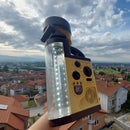Introduction: Fixing IKEA FIXA 7.2V Battery Drill That Won't Spin
Hi Everyone,
In this Instructable, we will repair this IKEA FIXA battery drill that starts spinning but it immediately stops with a bit of smoke coming out.
Supplies
Precision Screwdriver Set
http://s.click.aliexpress.com/e/egQx0Aek
Soldering Iron Kit
http://s.click.aliexpress.com/e/EcGyKtR2
Desk protection mat
http://s.click.aliexpress.com/e/B8j71Yyu
Step 1: Disassemble and Investigate the Issue
To start investigating the issue with the drill we first need to open up the case. It is held in place with 7 Philips screws on the right side that were really tight so I had to use quite some force.
After I removed all of the screws, I’ve carefully removed the sticker from the bottom of the drill and with the help of a flat head screwdriver I’ve pried opened the case to get a view of the drill internals.
On the inside, at the bottom, we have the charging port and the battery pack with the controller board on top. The output from the batteries is then connected to the switch where with the help of some MOSFETs the motor is controlled.
Step 2: Investigate Motor Internals
Since I was unable to identify any obvious fault, I continued by removing the motor from the gearbox in order to see if anything was seizing the motor from there but once I opened it I turned on the drill without anything connected to the motor and the same issue was still happening.
At this moment I knew that the issue was with the motor and I thought of ordering a new one online, but without special tools, removing the pinion will be a nightmare. So instead, I’ve decided to open up the motor and see if there is anything that can be done.
I used a flat head screwdriver to straighten the holding pins on the motor and with a bit of wiggling, I removed the plastic cover that holds the brushes.
Step 3: Clean the Motor Commutator
Here the problem became somewhat apparent as there was a lot of copper dust and grease that was on the commutator. Since the motor has three windings, there are three copper pads on the commutator and because of the contamination, they were all shorting with each other.
I then used a very thin flat screwdriver to remove all the dirt from between the commutator pads and a paper towel to wipe all of the greases from them. Additionally, I also cleaned the brushes so there was no residue left.
Looking at the motor windings, I was able to see some darkening on the wires which indicates that the motor has seen some abuse and eventually will need replacing but we can squeeze a bit more use out of it.
Step 4: Test and Assemble
To close it all up, I first aligned the shaft bearing with the shaft and carefully pulled the brushes in place making sure not to damage them. I’ve bent the holding pins back to hold the motor cover and I’ve just tacked the wires back to the motor in order to try it out.
Sure enough, the motor started spinning continuously so I knew that the fix worked. I’ve then fixed the solder connections with a bit of fresh solder and I returned the isolation sleaving on the motor pins.
The motor and the gearbox are assembled back together by first tightening the two screws that hold the motor in place and then after aligning the pinion with the rest of the gears inside I tightened the 4 screws that hold the gearbox.
I placed the gearbox and the motor back to the housing and after fixing all of the screws the repair was done.
If you liked the Instructable then be sure to subscribe to my YouTube channel and check out my other Instructables.











